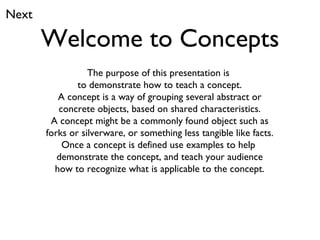
Concepts
- 1. Welcome to Concepts The purpose of this presentation is to demonstrate how to teach a concept. A concept is a way of grouping several abstract or concrete objects, based on shared characteristics. A concept might be a commonly found object such as forks or silverware, or something less tangible like facts. Once a concept is defined use examples to help demonstrate the concept, and teach your audience how to recognize what is applicable to the concept. Next
- 2. Generalization and Discrimination Two skills that are essential to this process are Generalization and Discrimination. Generalization is the process of removing irrelevant details. Different forks may be made from different materials but the definition of a fork does not take note of material. Discrimination is recognizing the essential details, if the utensil does not have multiple “teeth”, it is not a fork. Students may over-generalize and not be “picky” enough or under-generalize, and focus on irrelevant details. Next
- 3. Strategies The two main strategies for teaching a concept are Inquiry and Expository. Inquiry presents the audience with multiple examples, asking them to sort and theorize what the essential characteristics are. Expository presents the concept early on, clearly defining the defining characteristics, and then uses examples to reinforce those details. In the following slides you will see an example using the Expository Method. Next
- 4. How to Introduce Begin with a strong image to catch the interest. In this example we have an image containing many vivid colors, both warm and cool. Introduce the audience to the subject at hand, Color. “Some colors are described as warm, others cool. Today we will discuss what that means.” Next
- 5. Ease in-Past Knowledge Remind the audience of past knowledge they have already learned that is relevant to this concept. “ Everyone has studied colors. Everyone knows the basic 6; Red, Orange, Yellow, Green, Blue, Purple. And we have all seen how these 6 colors can manifest in a variety of combinations and shades.” Next
- 6. Define the Concept Define the concept clearly. Establish what attributes make something an example of this concept, or not. Warm colors are dominated by Red and/or Yellow. These include Orange, Red, Yellow, and shades of Green. Some colors are primary, the most basic, while others are a combination of two colors, or secondary and tertiary. Different shades or pigments are created depending on the ratios of those two colors. Cool colors are dominated by Blue. These include Blue, Purple, and some shades of Green. An image is warm or cool when most colors in it is either warm or cool. Next Next
- 7. Help Them Remember Try to offer any trick or method you know of to help remember the relevant attributes that distinguish an applicable example from a “non-example”. In this instance, you might suggest “warm fire” and “cool water”. Next
- 8. The First Examples Present two examples that are undeniable examples of the concept, and in most cases, not the concept. In this case, two images that are definitely warm and cool. Explain why these two examples fit the concept. Warm Cool The image on the right is a warm image because every color, other than black, is a warm color, reds, yellows, and oranges, and these colors represent the color majority. In Contrast, this image is dominated by blues and greens. Next
- 9. Additional Examples Next you provide the audience with multiple examples, some of which do and some of which do not fit the concept, or in this case, examples of warm and cool images. Ask the student to decide for themselves which are warm and which are cool. Next
- 10. Feedback If possible try to provide feedback for your audience. In the case of a presentation, pose questions which are designed so that in the process of answering them students evaluate their own methods of determining what the concept is applicable to. Next
- 11. Review Review the concept and the key attributes which identity something as applicable. In this case, remind your audience that warm colors are associated with the Yellow sun and the Red fire, because warm colors have more Reds and/or Yellows, while cool colors are associated with Blue water and the shade of Green leaves because cool colors have more Blues. Next
- 12. Discussion/Utilization Discuss how this new knowledge could be useful. In this instance, when creating an image or layout the audience can consider what their goal is, and whether that goal is best served by a warm or cool image. Home